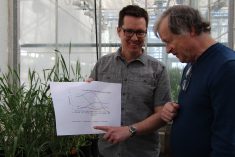Glacier FarmMedia – In 2022, Health Canada and Agriculture and Agri-Food Canada announced that crop varieties developed with gene editing technology will not be subject to the same regulatory requirements as genetically modified organisms.
Though many within the agriculture industry praised the decision as a win for crop breeders, and Canadians more generally, some academic researchers question whether individuals in the public sector will be able to seize the opportunity.
At issue for researchers is the fact that many end markets have taken a different regulatory stance than Canada on gene editing, and there is an ever-shrinking pool of research dollars.
Read Also

Best before doesn’t mean bad after
Best before dates are not expiry dates, and the confusion often leads to plenty of food waste.
Stuart Smyth, associate professor and chair of Agri-Food Innovation and Sustainability Enhancement at the University of Saskatchewan, is a long-time advocate of gene editing and other biotechnologies in agriculture.
For Smyth, the decisions made by Health Canada and AAFC bring a number of benefits, including support of Canadian farmers’ competitiveness compared to other countries that had previously adopted a similar regulatory classification – specifically Argentina, Australia, Brazil, and the United States. It also reduces the time it takes to develop new crop varieties from a decade or more to as little as three years.
With such potential in mind, Smyth expresses frustration over a steady decline in how much researchers have been able to squeeze from every government dollar.
“The biggest challenge is there is less funding year over year. There has been no real increase over the last couple decades, as budgets are held constant while inflation happens. There’s less to go around,” he says.
“It doesn’t matter who is applying … that ratchets up the competition. Either fewer projects get selected or the same number of projects get funded and projects need to scale back.”
Smyth’s overarching concern is, as the value of current research investment diminishes, Canadian farmers and businesses will face an increasing disadvantage internationally.
He considers commodity groups and other stakeholders within the agriculture sector to be in a better position when it comes to supporting crop breeders. Continued efforts to make the public aware of and interested in gene editing technologies, and how it could benefit them, would provide more incentive and opportunity for all stakeholders to invest in gene editing projects.
“The days of expecting the federal government to fund everything are gone. We need public-private and producer partnerships,” says Smyth.
“Everybody is at the table, but I think the federal government needs to signal that movement. If the feds are not providing any new grant opportunities, there’s less incentive there for others to make commitments.”
Challenging policies
Funding shortfalls aside, Smyth says some crop breeders are also hesitant to adopt gene editing for practical reasons, such as the costs and complexities incurred from retrofitting old labs. Not every breeder wants to deal with that, particularly those who might be closer to retirement.
Those working on crops destined for markets where gene editing is regulated differently than in Canada is another concern.
Indeed, it’s one Istvan Rajcan, professor of soybean breeding and genetics at the University of Guelph, knows well. He focuses entirely on food grade soybeans in his research program, and soybeans are commonly exported to markets in Europe, Japan, China and elsewhere. The classification of gene edited crops as genetically modified organisms in those markets is a persistent barrier.
“It boils down to where the markets are for the crops each individual plant breeder develops. That’s the main reason for me not using gene editing. It’s simply a practical decision,” says Rajcan, adding he does appreciate and see value in the technology.
“It just wouldn’t make sense. What’s the point of me developing a cultivar that Ontario farmers can grow, but has an issue exporting? I’ve never applied for funding for gene editing for this reason.”
Rajcan says he would consider projects involving gene editing if the regulatory environments in main export countries were to change. In Europe, at least, they might. How gene edited crops are classified is again being debated in the political block, after the European Commission submitted a proposal this summer to align legislation with new developments in biotechnology. The proposal reads as follows:
“New Genomic Techniques (NGT) are innovative tools that help increase the sustainability and resilience of our food system. They allow developing improved plant varieties that are climate resilient, pest resistant, that require less fertilisers and pesticides and can ensure higher yields, helping to cut the use and risk of chemical pesticides in half, and reducing the EU’s dependency on agricultural imports.
“In most cases, these new techniques lead to more targeted, precise, and faster changes than conventional techniques, while growing a crop that is the same as what could have been achieved with classic techniques like seed selection and crossbreeding.
“Our proposal will establish two categories of plants obtained by NGTs: NGT plants comparable to naturally occurring or conventional plants, and NGT plants with more complex modifications;
both categories will be subject to different requirements to reach the market, taking into account their different characteristics and risk profiles. The plants from the first category will need to be notified. The plants from the second category will go through the more extensive process of the GMO directive.”
Both Rajcan and Smyth find such developments encouraging. But for the time being, any gene edited crops and potential royalties from gene edited varieties will be limited to markets in Canada, the United States and other countries with similar gene editing regulations.
“I’m always a bit more of an optimist. Over the next few years we may see more gene editing being used as the European Union opens up to these technologies,” says Smyth.
“That might give some leverage for gene editing research in Canada.”
– Matt McIntosh is a contributor to Glacier FarmMedia.















